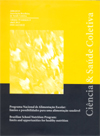1304/2012 - Prevalence and associated factors of hazardous alcohol use and alcohol dependence
Prevalência e fatores associados ao consumo abusivo e à dependência de álcool
Author:
• Luciano Nery Ferreira - Ferreira, L.N - Jequié, BA - UNIVERSIDADE ESTADUAL DO SUDOESTE DA BAHIA - DEPARTAMENTO DE SAÚDE - <lnery@uesb.edu.br>ORCID: https://orcid.org/0000-0002-9410-2467
Co-author(s):
• Antônio Carlos Ricardo Braga Júnior - Braga Júnior, ACR - UNIVERSIDADE FEDERAL DA BAHIA - INSTITUTO MULTIDISCIPLINAR EM SAÚDE - <antoniocarlosricardobragajunior@hotmail.com>• CEZAR AUGUSTO CASOTTI - Casotti, C.A. - Jequié, BA - UNIVERSIDADE ESTADUAL DO SUDOESTE DA BAHIA - DEPARTAMENTO DE SAÚDE - <cacasotti@uesb.edu.br>
• Zenilda Nogueira Sales - Sales, ZN - UNIVERSIDADE ESTADUAL DO SUDOESTE DA BAHIA - DEPARTAMENTO DE SAÚDE - <zenysalles@gmail.com>
• José Patrício Bispo Júnior - Bispo Júnior, JP - UNIVERSIDADE FEDERAL DA BAHIA - INSTITUTO MULTIDISCIPLINAR EM SAÚDE - <jpatricio@ufba.br>
ORCID: https://orcid.org/0000-0003-4155-9612
Thematic Area:
EpidemiologiaAbstract:
Aim: To estimate the prevalence of hazardous alcohol use and alcohol dependence and its associated factors in urban population of a city of northeastern Brazil.Methods: A population-based cross-sectional study that investigated the consumption of alcohol in 270 people living in the urban area of Jequié-BA. The hazardous alcohol use, defined by a score ≥ 8 from responses to the Alcohol Use Disorders Identification Test (AUDIT). Alcohol dependence was identified by a score ≥ 2 obtained in the application of the Cut down, Annoyed by criticism, Guilty and Eye-opener (CAGE). The analysis used the logistic regression model.
Results: The prevalence of hazardous alcohol use was 18.5%. For alcohol dependence was 10.4%. After adjusted analysis, the groups had a higher hazardous alcohol use were men (OR = 5.56) and young (OR = 5.41). Professing evangelical belief was inversely associated with hazardous alcohol use (OR = 0.04).
Conclusions: It was established an association between the hazardous alcohol use to young age, male gender, and smoking, while the observed inverse association with this outcome has evangelical religious beliefs.











